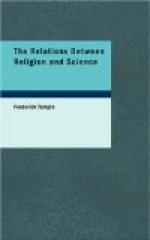But though the hold of the Bible on the faith of believers unquestionably depends on its satisfying the conscience in every stage of its enlightenment, it is equally certain that those who gave the messages recorded in the Bible claimed something more as proof of their authority than the approval of the conscience of their hearers. They professed to prove their mission by the evidence of supernatural powers; and the teaching of the Bible cannot be dissociated from the miraculous element in it which is connected with that teaching. If, indeed, the Old Testament stood alone we might acknowledge that the miraculous element in it occupied comparatively so small a place, and was so separable from the rest, and the evidence for it was so rarely, if ever, contemporaneous, that it might be left out of count. But we cannot say this of the New Testament, nor in particular of the account that has reached us of the sayings and doings of our Lord. The miracles are embedded in, are indeed intertwined with, the narrative. Many of our Lord’s most characteristic sayings are so associated with narratives of miracles that the two cannot be torn apart: ’I have not seen so great faith, no, not in Israel;’ ‘My Father worketh hitherto, and I work;’ ‘Son, thy sins be forgiven thee;’ ’Beware of the leaven of the Pharisees and the Sadducees;’ ’It is not meet to take the children’s bread and cast it to dogs;’ ‘This kind goeth not out but by prayer and fasting;’ ‘Were there not ten cleansed, but where are the nine?’ ’Sin no more, lest a worse thing come unto thee.’ In fact, there can be no




